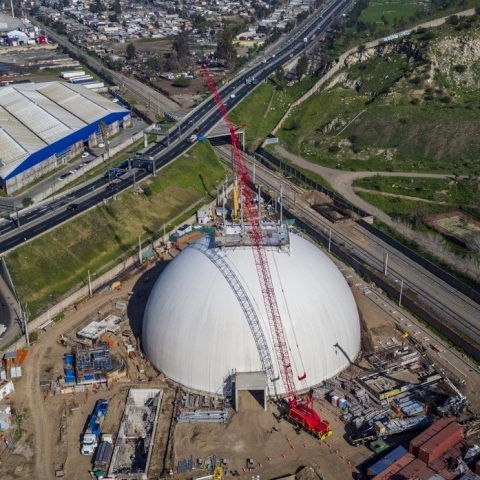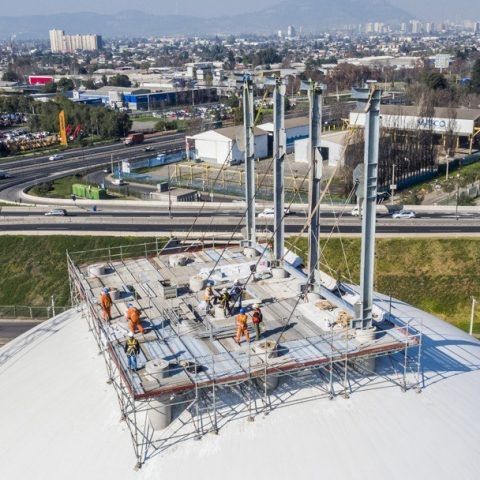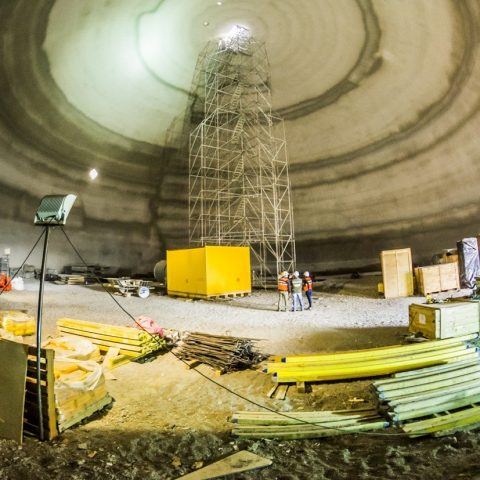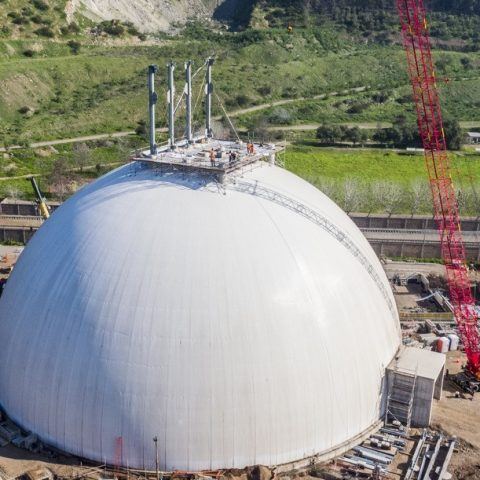Scope of Work
| Domes | Height | Diameter | Capacity |
|---|---|---|---|
| #590 | 93.5ft | 187ft | 50,000t |
| #590 | 28.5m | 57.0m | 50,000t |
Dome Technology builds a seismic-tolerant storage dome for BSA Cementos in Santiago, Chile
In planning for a new clinker storage site in Santiago, Chile, BSA Cementos needed massive storage that would stay secure, no matter how much the earth might shake.
The company contracted Dome Technology to build the dome for the project, which is nearing completion, that will hold up to 50,000 metric tons of clinker and stand 28.5 meters (93.5 ft) high and 57 meters (187 ft) in diameter.
The contract for the project is with SALFA Montajes S.A., and the final customer is BSA Cementos. The dome is located at a new site where BSA Cementos will be able to increase its production by 950,000 tons per year during the first stage of operation, with as much as 1,900,000 tons a year being processed per year. The dome will be the first large structure on site.
According to Dome Technology Vice President of Operations Dan South, BSA Cementos was initially considering conventional silos with steel roofs. After multiple meetings with Dome Technology, BSA Cementos opted for a hemispherical dome instead. “The customer was looking for the most economical solution, ensuring they received a good value,” South said.
Selecting a dome “has several technical advantages that will eventually be reflected in economic benefits for our final customer,” said Nilo Araya Gonzalez of SALFA Montajes, head of supplies for the BSA project, adding that quick construction time, a smaller construction crew and a low-maintenance final product were key advantages. “Moreover, the dome’s building technology allows for a large storage capacity under one structure, avoiding the use of multiple reclaim systems,” he said.
The plant is expected to have a continuous supply of clinker from the port for production, and “this dome allows the customer to have a 50,000-metric-ton stock of clinker in case there is a delay with shipping from the port,” said Dome Technology operations manager Eudaldo Chavez Zazueta said. “This enables them to respond to the local market effectively without disrupting the factory’s production output and increasing reliability of their whole operation.”
A substantial headhouse placed at the dome’s apex houses large equipment, conveyors and dust-control systems, a load that can be supported because “our dome has been designed to handle the loads and stress, even in a seismic event,” Chavez said. The dome will not include tunnels as product loading will happen via a conveyor system running through the apex; a front-end loader will unload the clinker through a main door.
According to Chavez, the customer opted for the simplest reclaim solution: front-end loaders that are also used for other factory needs. Relying on loaders allows for minimal equipment downtime and will be sufficient since stock rotation inside the dome will be minimal.
Coppex Engineering & Technologies in Chile was instrumental in securing the project, highlighting for the customer the inherent strength of the reinforced concrete dome in conjunction with competitive price and architectural design. “Coppex had the local contacts, and Dome Technology the best experience with the required flexibility to adapt to the client requirements,” said Gerardo Renner of Coppex.
Seismic tolerance: Qualities that make domes secure
Chile is known for its seismic activity, “but even more important than that, we are known to have one of the most rigorous building codes regarding the considerations to be accounted for when doing any type of construction,” Araya said. ”The dome’s geometry gives it excellent stability and load-absorption characteristics; therefore, this design has important advantages in meeting seismic requirements that are mandatory in our country, which will as well translate into savings during construction.”
Domes are especially suited to meet seismic requirements thanks to the inherent double curvature of a dome shell. “Their robust nature comes from the fact that the dome has the ability to distribute a given load in two directions, resulting in twice the strength of a single curved wall, such as that used in traditional silos,” said engineer for Dome Technology Doug Weber.
A seamless shell, comprised of reinforced concrete combined with the double curvature, makes it possible for a dome to more economically withstand given seismic forces and differential movements at its base. In addition, the dome is free of joints or seams, which eliminates weak areas and stress concentrations, Weber said.
The dome’s geometry is complemented by concrete and reinforcing steel. These two produce the perfect marriage of strength and resiliency. The dome consists of polyurethane foam insulation, steel reinforcing and concrete.
At sites where settlement is a concern, domes can be designed to tolerate several inches of movement; however, there may be other solutions besides deep (and expensive) foundations. Dome Technology helps customers explore options that often reduce costs by selecting an alternative foundation solution that delivers necessary support at the base.
Domes are also an effective and resilient option for regions likely to experience hurricanes or tornadoes; Dome Technology has built structures capable of withstanding winds as high as 300 mph. During projectile testing, a 2X4 shot at the dome at 90 mph penetrated the outer weatherproofing membrane and insulation layer but splintered upon impact with the reinforced concrete dome.
As the project nears completion
Project completion is expected in early April 2017. According to South, the work with SALFA was successful, and building a dome in a large city like Santiago provides positive exposure and greater awareness about what Dome Technology does for bulk-storage companies.
“We brought the project in on time, on budget, (and) we were the first contractor on the job site and first one off. We have a satisfied customer and a satisfied general contractor, and we look forward to doing more projects in South American for enclosed cement storage,” South said.







